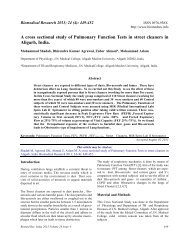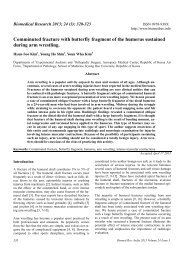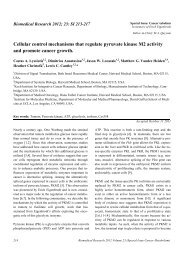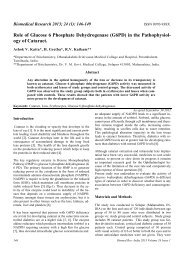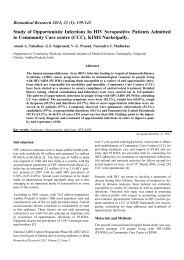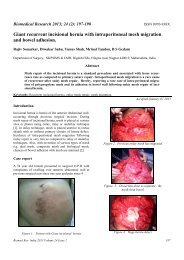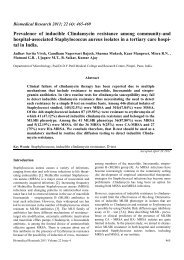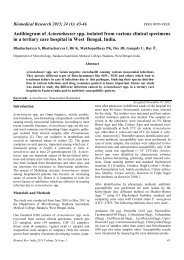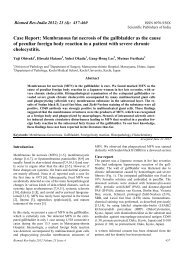Comparative study of trace elements and serum ceruloplasmin level ...
Comparative study of trace elements and serum ceruloplasmin level ...
Comparative study of trace elements and serum ceruloplasmin level ...
Create successful ePaper yourself
Turn your PDF publications into a flip-book with our unique Google optimized e-Paper software.
Biomedical Research 2011; 22 (2): 207-210<br />
<strong>Comparative</strong> <strong>study</strong> <strong>of</strong> <strong>trace</strong> <strong>elements</strong> <strong>and</strong> <strong>serum</strong> <strong>ceruloplasmin</strong> <strong>level</strong> in<br />
normal <strong>and</strong> pre-eclamptic pregnancies with their cord blood<br />
1 Savita Rathore, 2 Ashish Gupta, 3 Hitender Singh Batra, 1 Rajkumari Rathore<br />
1 Department <strong>of</strong> Biochemistry, Index Medical College, Indore, Madhya Pradesh, India<br />
2 Department <strong>of</strong> Transfusion Medicine <strong>and</strong> Blood Bank, Chhatrapati Shahuji Maharaj Medical University (Earlier King<br />
Georg’s Medical University), Lucknow, Uttar Pradesh, India.<br />
3 Department <strong>of</strong> Biochemistry, Armed Forces Medical College, Pune, India<br />
Abstracts<br />
The aim <strong>of</strong> the present <strong>study</strong> is to assess the comparison <strong>of</strong> <strong>trace</strong> <strong>elements</strong> <strong>and</strong> <strong>serum</strong> <strong>ceruloplasmin</strong><br />
<strong>level</strong> in normal <strong>and</strong> pre-eclamptic pregnancies with their cord blood. Pregnancy is<br />
associated with increased dem<strong>and</strong> <strong>of</strong> all the micronutrients like Iron, Copper, Zinc, Vit B12,<br />
Folic acid <strong>and</strong> Ascorbic acid. The pregnant women were admitted in maternity ward, Department<br />
<strong>of</strong> Obstetric <strong>and</strong> Gynecology, Comm<strong>and</strong> Hospital, Pune. The <strong>study</strong> group comprised<br />
<strong>of</strong> 61 pregnant women <strong>and</strong> their newborns. Venous blood (5 ml.) was collected from<br />
mother at the time <strong>of</strong> delivery <strong>and</strong> cord blood (10 ml.) was taken from maternal end <strong>of</strong> umbilical<br />
cord. Of 61 pregnant women, 14 were pre-eclamptic <strong>and</strong> 47 were normal pregnant<br />
women. In normal pregnancy, the copper & <strong>ceruloplasmin</strong> concentration were statistically<br />
significantly increased (p
glucose (sugar) in the body. Hypertension is unique to<br />
pregnancy <strong>and</strong> it is a clinical syndrome that affects both<br />
mother <strong>and</strong> fetus. There is evidence that pre-eclampsia<br />
develops as a sequence <strong>of</strong> alterations in the vasculature<br />
supplying blood to the placenta. These alterations in placental<br />
circulation probably occur in early second trimester,<br />
whereas the maternal manifestations <strong>of</strong> the disease are<br />
not apparent until late in pregnancy, most <strong>of</strong>ten near term.<br />
Pre-eclampsia, a pregnancy specific disorder is a leading<br />
cause <strong>of</strong> maternal mortality <strong>and</strong> increases perinatal mortality.<br />
The clinical diagnosis is based on the new onset <strong>of</strong><br />
hypertension <strong>and</strong> appearance <strong>of</strong> proteinuria, oedema during<br />
pregnancy after 20 weeks <strong>of</strong> gestation. It is more<br />
common in nalliparous women, the incidence in such<br />
women ranging from 2-10% in different population [5, 6].<br />
Zinc is transferred across the placenta to the fetus against<br />
a concentration gradient <strong>and</strong> taken up there after by the<br />
fetus. Pregnancy associated with significant physiological<br />
changes, which increases the dem<strong>and</strong> for iron. Iron is<br />
most important <strong>trace</strong> element <strong>and</strong> it also an essential<br />
component <strong>of</strong> hemoglobin synthesis. Iron is needed for<br />
additional erythrocyte production during pregnancy. It is<br />
estimated approximately 750-800 mg <strong>of</strong> elemental iron is<br />
required for entire pregnancy [7]. Serum <strong>ceruloplasmin</strong> is<br />
an α-2, copper transporting globulin synthesized in liver<br />
microsomes <strong>and</strong> possesses feroxidase activity. It acts as<br />
an antioxidant in <strong>serum</strong> by oxidizing ferrous iron which<br />
could otherwise act as a catalyst in generating toxic free<br />
radicals [8]. The present <strong>study</strong> was done to assess the<br />
comparison <strong>of</strong> <strong>trace</strong> <strong>elements</strong> <strong>and</strong> <strong>serum</strong> <strong>ceruloplasmin</strong><br />
<strong>level</strong> in normal <strong>and</strong> pre-eclamptic pregnancies with their<br />
cord blood.<br />
Material <strong>and</strong> Methods<br />
The <strong>study</strong> was conducted in Department <strong>of</strong> Biochemistry,<br />
Armed Forces Medical College in association with Department<br />
<strong>of</strong> Obstetric <strong>and</strong> Gynecology, Comm<strong>and</strong> Hospital,<br />
Pune. The pregnant women were admitted in maternity<br />
ward, Department <strong>of</strong> Obstetric <strong>and</strong> Gynecology,<br />
Comm<strong>and</strong> Hospital, Pune. The <strong>study</strong> group was comprised<br />
<strong>of</strong> 61 pregnant women during labor ranging in age<br />
from 19-35 years <strong>and</strong> their newborns. In which, 14 cases<br />
Rathore/Gupta/Batra/Rathore<br />
were pre-eclamptic (having hypertension, proteinuria <strong>and</strong><br />
oedema) while 47 were normal pregnant women. Women<br />
with obstetrical condition like multiple pregnancy, gestational<br />
diabetes <strong>and</strong> history <strong>of</strong> cesarean, breech delivery<br />
were excluded. Venous blood (5 ml.) was collected from<br />
mother at the time <strong>of</strong> delivery <strong>and</strong> cord blood (10 ml.)<br />
was taken from maternal end <strong>of</strong> umbilical cord to coinside<br />
precisely with newborns venous blood <strong>level</strong>s. The<br />
samples were transferred to labeled sterile vials <strong>and</strong> allowed<br />
to clot at room temperature. Blood was centrifuged<br />
at 3000 rpm for 5 minutes. The supernatant was used to<br />
quantify the copper <strong>and</strong> iron (Crest Biosystem, Goa) by<br />
semi autoanalyzer (Microlab 300, Merck, Vital Scientific,<br />
N.V., Dieren, Netherl<strong>and</strong>s). Zinc was estimated by<br />
atomic absorption spectrometry (AAS) method [9]. Serum<br />
<strong>ceruloplasmin</strong> was estimated by kinetic method [10] on<br />
Shimadzu CL-750 spectrophotometer.<br />
Statistical Analysis<br />
Data was reported as mean ± st<strong>and</strong>ard deviation (SD).<br />
The data was compared using ANOVA “t”-test. The confidence<br />
limit was kept at 95%, hence a “p” value
Cu, Fe, Zn <strong>and</strong> Cp in pregnancy <strong>and</strong> cord blood<br />
Discussion<br />
Pregnancy is a period <strong>of</strong> rapid growth <strong>and</strong> cell differentiation<br />
for both the mother <strong>and</strong> fetus. Consequently, it is a<br />
period both are vulnerable to changes in dietary supply,<br />
especially <strong>of</strong> those micronutrients that are marginal under<br />
normal circumstances. In developed countries this vulnerability<br />
applies mainly to micronutrients. Iron deficiency is<br />
a common disorder, especially in pregnancy [11]. Preeclampsia<br />
is the most common medical complication <strong>of</strong><br />
pregnancy associated with increased maternal <strong>and</strong> infant<br />
mortality <strong>and</strong> morbidity. The exact etiology is not known,<br />
although several evidences indicate that various <strong>elements</strong><br />
might play an important role in pre-eclampsia [12].<br />
In the present <strong>study</strong> we observed that the <strong>serum</strong> copper<br />
<strong>and</strong> <strong>ceruloplasmin</strong> <strong>level</strong>s were higher in maternal blood<br />
than cord blood in normal pregnancies. The copper difference<br />
was found statistically significant while the <strong>ceruloplasmin</strong><br />
was observed highly statistically significant<br />
between maternal <strong>and</strong> cord blood. The maternal blood<br />
<strong>ceruloplasmin</strong> was observed about five times greater than<br />
cord blood. This is due to non-transportation <strong>of</strong> <strong>ceruloplasmin</strong><br />
across the placenta; hence its circulation in the<br />
cord blood must be, entirely <strong>of</strong> fetal origin.<br />
In the present <strong>study</strong>, pre-eclamptic pregnancies the copper<br />
<strong>and</strong> <strong>ceruloplasmin</strong> concentration was observed to the<br />
similar significant difference between maternal <strong>and</strong> cord<br />
blood as normal pregnancies. On comparison between<br />
normal <strong>and</strong> pre-eclamptic pregnancies the <strong>serum</strong> copper<br />
<strong>and</strong> <strong>ceruloplasmin</strong> concentration was decreased in preeclemptic<br />
pregnancies than normal pregnancies. Parveen<br />
S et al (2002) [13] reported that the copper remains in<br />
cord blood plasma at much lower conc. than in the<br />
mother, suggesting that prematurity may place the newborn<br />
infant at a greater risk than the term infant to copper<br />
deficiency. This situation, together with a reduced synthesis<br />
in the fetus <strong>of</strong> the transport protein <strong>ceruloplasmin</strong>, creates<br />
another potential challenger in the nutritional support<br />
<strong>of</strong> the premature infants.<br />
The <strong>serum</strong> zinc <strong>and</strong> iron conc. were significantly higher in<br />
cord blood than maternal blood in normal pregnancies.<br />
The increased fetal iron dem<strong>and</strong> or maternal iron insufficiency<br />
is related to both an increase in the expression <strong>of</strong><br />
placental transferrin receptor on the syncytiotrophoblast<br />
<strong>and</strong> an increase in the expression <strong>of</strong> the ferritin receptor in<br />
the placental microvilli membrane. Expression <strong>of</strong> the endosomal<br />
membrane iron transporter, divalent metal ion<br />
transporter (DMT-1), has also been shown to be involved<br />
in the transfer <strong>of</strong> iron from the syncytiotrophoblastic endosome<br />
into the cytoplasm. Moreover, placental iron<br />
regulatory protein 1 activity has been directly related to<br />
transferrin receptor messenger RNA concentrations in<br />
human placenta, <strong>and</strong> expression <strong>of</strong> this protein has been<br />
found to be related to the iron content <strong>of</strong> the placenta [14].<br />
Zn is passively transferred from mother to fetus across the<br />
Biomedical Research 2011 Volume 22 Issue 2<br />
placenta <strong>and</strong> there is also decreased Zn binding capacity<br />
<strong>of</strong> maternal blood during pregnancy which facilitates efficient<br />
transfer <strong>of</strong> Zn from mother to fetus resulting in an<br />
increase <strong>level</strong> <strong>of</strong> Zn in cord blood. Zn is essential for<br />
proper growth <strong>of</strong> fetus <strong>and</strong> the fall in Zn during pregnancy<br />
could also be a physiological response to exp<strong>and</strong>ed<br />
maternal blood volume [15]. Islam M et al (1994) [16]<br />
reported that the increased zinc in cord blood suggested<br />
that may be due to efficient transfer <strong>of</strong> zinc from mother<br />
to fetus irrespective <strong>of</strong> maternal status <strong>and</strong> high proteosynthetic<br />
activity in fetus. The decreased zinc in maternal<br />
blood is attributed by some workers to physiological adjustment<br />
in response to exp<strong>and</strong>ed maternal blood volume.<br />
The placental transfer <strong>of</strong> zinc, as inferred from maternal<br />
<strong>and</strong> fetal concentrations <strong>of</strong> zinc, is similar in normal<br />
pregnancies, pregnancies with intrauterine growth retardation,<br />
<strong>and</strong> pre-eclamptic pregnancies is transferred across<br />
the placenta to the fetus against a concentration gradient<br />
<strong>and</strong> is taken up there after by the fetus.<br />
On comparison between normal <strong>and</strong> pre-eclamptic pregnancies,<br />
the <strong>serum</strong> zinc was observed in significantly decreased<br />
in pre-eclamptic pregnancies. Kumrus et al<br />
(2003) [17] reported that the assessment <strong>of</strong> <strong>trace</strong> <strong>elements</strong><br />
in normal <strong>and</strong> pre-eclamptic pregnancies. They observed<br />
that the <strong>serum</strong> zinc <strong>and</strong> copper (p< 0.001) <strong>level</strong>s significantly<br />
lower in pre-eclamptic pregnancies as compared to<br />
normal pregnancies.<br />
Conclusion<br />
Iron deficiency is a common disorder, especially in pregnancy.<br />
Our <strong>study</strong> infers that iron is the most important<br />
micronutrient <strong>and</strong> it should be supplemented as a daily<br />
requirement in pregnant women. Ceruloplasmin is higher<br />
in normal pregnancies in comparison to pr-eclamptic<br />
pregnancies hence it can be used as a diagnostic measurement<br />
in pregnancy period.<br />
References<br />
1. Naeye R, Blane W, Paul C. Effects <strong>of</strong> Maternal Nutrition<br />
on Human Fetus. Pediatr 1973; 52: 494-503.<br />
2. Black RE. Micronutrients in Pregnancy.Br J Nutr 2001;<br />
85:193-197.<br />
3. AMA Nutrition Advisory Group. Guideline for Essential<br />
Trace Elements Preparation for Parinatal Use. J<br />
Parenter Enteral Nutr 1979; 3: 263-269.<br />
4. AMA Department <strong>of</strong> Foods <strong>and</strong> Nutrition. Guideline<br />
for Essential Trace Elements Preparation for Parinatal<br />
Use: A Statement by Expert Panel JAMA 1979;<br />
241:2051-2055.<br />
5. Moutquin J. M., Rainville C., Giroux L. A Prospective<br />
Study <strong>of</strong> Blood Pressure in Pregnancy: Prediction <strong>of</strong><br />
Pre-Eclampsia. Am J Obstet Gynecol. 1985; 151: 191-<br />
195.<br />
6. Saftlas AF, Olson DR, Franks AL. Epidemiology <strong>of</strong><br />
Pre-Eclampsia <strong>and</strong> Eclampsia in the United Stated. Am<br />
J Obstet Gyneocol 1990; 163: 460-464.<br />
209
7. National Research Council. Recommended Dietary<br />
Allowances. 10 th ed. Washington, DC, National Academy<br />
Press 1989.<br />
8. Batra HS, Singh P, Somani BL, Gupta A, Sampath S,<br />
Ambade V. Serum ferroxidase albumin ratio as a<br />
marker in pulmonary tuberculosis. Ind J Clin Biochem<br />
2007; 22: 106-108.<br />
9. Wildman REC, Medeiros DM. Advanced human nutrition.<br />
Boca Raton, CRC Press, 2000.<br />
10. Somani BL, Ambade V. Novel composition for kinetic<br />
assay <strong>of</strong> <strong>ceruloplasmin</strong>. Clin Chem 2005; 51: Suppl<br />
A90.<br />
11. Gambling L, McArdle HJ. Iron, Copper <strong>and</strong> Fetal Development.<br />
Proc Nutr Soc 2004; 63: 553-62.<br />
12. Jain S, Sharma P, Kulsheshtha S, Mohan G, Singh S.<br />
The Role <strong>of</strong> Calcium, Magnesium, <strong>and</strong> Zinc in Pre-<br />
Eclampsia. Biol Trace Elem Res 2009; 22: 104-109.<br />
13. Perveen S, Altaf W, Vohra N, Bautista ML, Harper<br />
RG, Wapnir RA. Effect <strong>of</strong> Gestational Age on Cord<br />
Blood Plasma Copper, Zinc, Magnesium <strong>and</strong> Albumin.<br />
Early Hum Dev 2002; 69:15-23.<br />
14. Kimberly O B, Nelly Z, Steven A. Maternal iron status<br />
influences iron transfer to the fetus during the third trimester<br />
<strong>of</strong> pregnancy. American J Clin Nutr 2003; 77:<br />
924-930.<br />
15. Chitra U. Serum iron, copper <strong>and</strong> zinc status in maternal<br />
<strong>and</strong> cord blood. Indian J clin Biochem 2004; 19:<br />
48-52.<br />
16. Islam MA, Memalatha P, Bhaskaram P, Kumar PA,<br />
Leukocyte <strong>and</strong> Plasma Zinc in Maternal <strong>and</strong> Cord<br />
Blood their Relationship to Period <strong>of</strong> Gestation <strong>and</strong><br />
Birth Weight. Nutr Res 1994; 14: 353-360.<br />
17. Kumru S, Aydin S, Simsek M, Sahin K, Yaman M.<br />
Comparison <strong>of</strong> Serum Copper, Zinc, Calcium, <strong>and</strong><br />
Magnesium Levels in Pre-Eclamptic <strong>and</strong> Healthy Pregnant<br />
Women. Biol Trace Elem Res 2003; 94: 105-112.<br />
Correspondence to:<br />
Ashish Gupta<br />
Department <strong>of</strong> Transfusion Medicine <strong>and</strong> Blood Bank<br />
Chhatrapati Shahuji Maharaj Medical University<br />
(Earlier King Georg’s Medical University)<br />
Lucknow 226003, Uttar Pradesh<br />
India.<br />
Rathore/Gupta/Batra/Rathore<br />
210 Biomedical Research 2011 Volume 22 Issue 2



